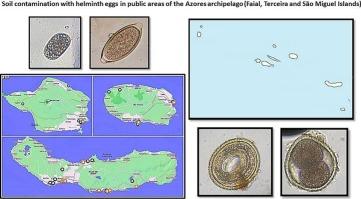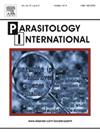Soil-transmitted helminth eggs in public areas of Azores archipelago, Portugal
IF 1.9
4区 医学
Q3 PARASITOLOGY
引用次数: 0
Abstract
In the Azores archipelago, data regarding environmental contamination by soil-transmitted helminths (STHs) is inexistent till the moment. The current study aimed to assess the environmental contamination with helminth eggs, in soil samples collected from public parks/gardens and beaches from three islands belonging to the Azores archipelago (Portugal): Faial, Terceira and São Miguel. Between June–December 2024, a total of 37 soil samples were collected from 26 public parks/gardens and 11 public beaches, and processed using the Mini-FLOTAC method to calculate parasites' prevalences and burdens (eggs/oocysts per gram of soil, EPG/OPG). Overall, a total of 35 % of the sampled sites were contaminated with helminth eggs, with the environmental contamination being higher in public parks or gardens (46 %), in comparison with beach areas (9 %). The majority of positive sites were contaminated with Toxocara spp. eggs (30 %), followed by Ancylostomatidae (11 %) and Trichuris spp. (11 %) eggs. São Miguel and Terceira islands presented higher rates of soil contamination, when compared to Faial Island. The overall helminth egg intensity was the following: Toxocara spp. (157 EPG), Trichuris spp. (59 EPG) and Ancylostomatidae (38 EPG). Faial island presented the lowest EPG levels, regarding all parasite species, being Toxocara spp. EPG levels significantly lower than the remaining islands surveyed (p = 0.02). The present study provides new and relevant data concerning environmental contamination by STHs with zoonotic potential in the Azores archipelago, and revealed that the analysis of soil samples is an important approach to be included in integrated pet parasite control programs.

葡萄牙亚速尔群岛公共区域土壤传播的蠕虫卵
在亚速尔群岛,目前还没有关于土壤传播蠕虫(STHs)污染环境的数据。目前的研究旨在评估从亚速尔群岛(葡萄牙)的三个岛屿(Faial, Terceira和s o Miguel)的公园/花园和海滩收集的土壤样本中的蠕虫卵对环境的污染。在2024年6月至12月期间,从26个公园/花园和11个公共海滩收集了37份土壤样本,并使用Mini-FLOTAC方法进行处理,计算寄生虫的流行率和负担(每克土壤中卵/卵囊,EPG/OPG)。总体而言,35%的采样地点被蠕虫卵污染,与海滩地区(9%)相比,公园或花园的环境污染程度更高(46%)。以弓形虫虫卵污染最多(30%),其次是钩虫虫卵(11%)和毛滴虫虫卵(11%)。与法亚尔岛相比,米格尔岛和特塞拉岛的土壤污染率更高。虫卵总密度依次为:弓形虫(157 EPG)、毛虫(59 EPG)和钩虫(38 EPG)。在所有寄生虫种类中,法亚尔岛的EPG水平最低,为弓形虫,显著低于其他岛屿(p = 0.02)。本研究提供了亚速尔群岛具有人畜共患潜力的海生虫污染环境的最新相关数据,并揭示了土壤样品分析是宠物寄生虫综合控制计划的重要方法。
本文章由计算机程序翻译,如有差异,请以英文原文为准。
求助全文
约1分钟内获得全文
求助全文
来源期刊

Parasitology International
医学-寄生虫学
CiteScore
4.00
自引率
10.50%
发文量
140
审稿时长
61 days
期刊介绍:
Parasitology International provides a medium for rapid, carefully reviewed publications in the field of human and animal parasitology. Original papers, rapid communications, and original case reports from all geographical areas and covering all parasitological disciplines, including structure, immunology, cell biology, biochemistry, molecular biology, and systematics, may be submitted. Reviews on recent developments are invited regularly, but suggestions in this respect are welcome. Letters to the Editor commenting on any aspect of the Journal are also welcome.
 求助内容:
求助内容: 应助结果提醒方式:
应助结果提醒方式:


